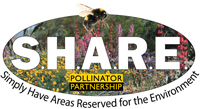How to and requirements for registering for S.H.A.R.E.
We encourage EVERYONE to S.H.A.R.E. their habitat with pollinators! You can develop landscape plantings that provide pollinator habitat by planting for pollinators, monitoring for pollinators, and reducing your impact. Click here to see the sign.
| Step 1: Plan and Plant Whether you are a farmer of many acres, a land manager of a large tract of land, or a gardener with a small lot, you can increase the number of pollinators in your area by making conscious choices to include plants that provide essential habitat for bees, butterflies, moths, beetle, hummingbirds, and other pollinators. As you begin to plan and plant, be sure to include elements that provide food, shelter, and water for pollinators. |
|
Food
|
 |
Shelter
|
 |
Water
|
 |
Step 2: Register
We encourage EVERYONE to S.H.A.R.E. their habitat with pollinators! Now that you have developed landscape plantings that provide pollinator habitat by planting for pollinators, register with S.H.A.R.E. to be recognized for your efforts to protect and conserve pollinators. Simply tell us about your landscape by registering your S.H.A.R.E. site here.
Step 3: Monitor
Observe wildlife activity in your farm fields, woodlands, and gardens to determine what actions you can take to encourage other pollinators to feed and nest. Evaluate the placement of individual plants and water sources and use your knowledge of specific pollinator needs to guide your choice and placement of additional plants and other habitat elements. Minor changes by many individuals can positively impact the pollinator populations in your area. Be sure to keep a record of your observations. We have provided you with an optional free to download monitoring data sheet. Click here to download yours.
Watch for - and enjoy - the changes in your landscape!
Step 4: Report
We want to hear from you! Applicants that have registered and met the S.H.A.R.E. registration requirements are encouraged to report on the status of their pollinator landscape monitoring by emailing SHARE@pollinator.org. Registered S.H.A.R.E. applicants that report on their pollinator landscape will receive an e-certificate, access to free online materials and have the option to receive a printed S.H.A.R.E. site sign by donating $20.00.

